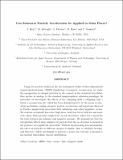Files in this item
Can substorm particle acceleration be applied to solar flares?
Item metadata
| dc.contributor.author | Birn, Joachim | |
| dc.contributor.author | Battaglia, Marina | |
| dc.contributor.author | Fletcher, Lyndsay | |
| dc.contributor.author | Hesse, Michael | |
| dc.contributor.author | Neukirch, Thomas | |
| dc.date.accessioned | 2017-10-24T15:30:07Z | |
| dc.date.available | 2017-10-24T15:30:07Z | |
| dc.date.issued | 2017-10-20 | |
| dc.identifier | 251204574 | |
| dc.identifier | ca4b4260-425b-4552-9e72-1ab4a0d2ff5c | |
| dc.identifier | 85032838627 | |
| dc.identifier | 000413339200016 | |
| dc.identifier.citation | Birn , J , Battaglia , M , Fletcher , L , Hesse , M & Neukirch , T 2017 , ' Can substorm particle acceleration be applied to solar flares? ' , Astrophysical Journal , vol. 848 , no. 2 , 116 . https://doi.org/10.3847/1538-4357/aa8ad4 | en |
| dc.identifier.issn | 0004-637X | |
| dc.identifier.other | ORCID: /0000-0002-7597-4980/work/38124085 | |
| dc.identifier.uri | https://hdl.handle.net/10023/11912 | |
| dc.description.abstract | Using test particle studies in the electromagnetic fields of three-dimensional magnetohydrodynamic (MHD) simulations of magnetic reconnection, we study the energization of charged particles in the context of the standard two-ribbon flare picture in analogy to the standard magnetospheric substorm paradigm. In particular, we investigate the effects of the collapsing field ("collapsing magnetic trap") below a reconnection site, which has been demonstrated to be the major acceleration mechanism that causes energetic particle acceleration and injections observed in Earth's magnetotail associated with substorms and other impulsive events. We contrast an initially force-free, high-shear field (low beta) with low and moderate shear, finite-pressure (high-beta) arcade structures, where beta represents the ratio between gas (plasma) and magnetic pressure. We demonstrate that the energization affects large numbers of particles, but the acceleration is modest in the presence of a significant shear field. Without incorporating loss mechanisms, the effect on particles at different energies is similar, akin to adiabatic heating, and thus is not a likely mechanism to generate a power-law tail onto a (heated or not heated) Maxwellian velocity distribution. | |
| dc.format.extent | 14 | |
| dc.format.extent | 3600307 | |
| dc.language.iso | eng | |
| dc.relation.ispartof | Astrophysical Journal | en |
| dc.subject | Acceleration of particles | en |
| dc.subject | Sun: corona | en |
| dc.subject | Sun: flares | en |
| dc.subject | Sun: magnetic fields | en |
| dc.subject | Sun: particle emission | en |
| dc.subject | QB Astronomy | en |
| dc.subject | QC Physics | en |
| dc.subject | NDAS | en |
| dc.subject.lcc | QB | en |
| dc.subject.lcc | QC | en |
| dc.title | Can substorm particle acceleration be applied to solar flares? | en |
| dc.type | Journal article | en |
| dc.contributor.sponsor | Science & Technology Facilities Council | en |
| dc.contributor.institution | University of St Andrews. Applied Mathematics | en |
| dc.contributor.institution | University of St Andrews. School of Mathematics and Statistics | en |
| dc.identifier.doi | 10.3847/1538-4357/aa8ad4 | |
| dc.description.status | Peer reviewed | en |
| dc.identifier.grantnumber | ST/N000609/1 | en |
This item appears in the following Collection(s)
Items in the St Andrews Research Repository are protected by copyright, with all rights reserved, unless otherwise indicated.

